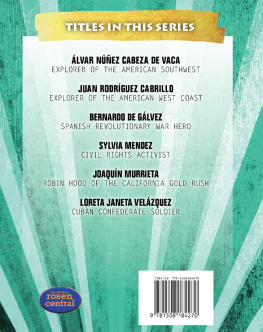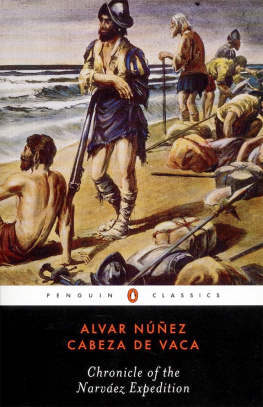Imaginary Cities of Gold
ALSO BY PETER O. KOCH
AND FROM MCFARLAND
The Spanish Conquest of the Inca Empire (2008)
The Aztecs, the Conquistadors, and the Making of Mexican Culture (2006)
To the Ends of the Earth: The Age of the European Explorers (2003)
Imaginary Cities of Gold
The Spanish Quest for Treasure in North America
PETER O. KOCH
McFarland & Company, Inc., Publishers
Jefferson, North Carolina, and London
LIBRARY OF CONGRESS CATALOGUING-IN-PUBLICATION DATA
Koch, Peter O., 1953
Imaginary cities of gold : the Spanish quest for treasure in North America / Peter O. Koch.
p. cm.
Includes bibliographical references and index.
ISBN 978-0-7864-4381-9
softcover : 50# alkaline paper
1. AmericaDiscovery and explorationSpanish. 2. Nez Cabeza de Vaca, Alvar, 16th cent. 3. Coronado, Francisco Vsquez de, 15101554. 4. Soto, Hernando de, ca. 15001542. 5. ExplorersAmericaBiography. 6. Explorers SpainBiography. 7. Geographical myths. I. Title. E123.K65 2009
970.01'6dc22 2009006678
British Library cataloguing data are available
2009 Peter O. Koch. All rights reserved
No part of this book may be reproduced or transmitted in any form or by any means, electronic or mechanical, including photocopying or recording, or by any information storage and retrieval system, without permission in writing from the publisher.
Cover image 2009 Shutterstock
Manufactured in the United States of America
McFarland & Company, Inc., Publishers
Box 611, Jefferson, North Carolina 28640
www.mcfarlandpub.com
For Abelene, Sara, Alex, and Eric; and for my extended family, Betty, Augusto, Mabelle, Joel, Meng, and Alpha: your love and support mean everything.
Let the curious reader consider whether there is not much to ponder in this that I am writing. What men have there been in the world who have shown such daring?
Bernal Diaz del Castillo
They were all groping in the darkness, because they did not understand what the Indians were saying.
Fray Bartolom de Las Casas
PREFACE
Nearly a century before a small company of hopeful English colonists sought to plant a permanent settlement at Jamestown, Spanish colonists, who had already established a foothold in North America, were busy planning expeditions to explore, conquer, and settle the mysterious lands that lay just to the north of Cuba and Mexico. Their curiosity piqued by native tales of lands teeming with a natural supply of precious metals and gems, and uncharted regions that were home to many strange and wondrous sights, some of which seemed to correspond with ancient European lore, a great many Spaniards were willing to risk everything, including their lives, for the chance to find treasures said to surpass even their wildest dreams.
A mere twenty years after Christopher Columbus established the first truly permanent European settlement in the Americas, a conquistador by the name of Juan Ponce de Len sailed from Puerto Rico in search of the island of Bimini, a land that the natives had told him was rich with gold and home to a magical spring of water that could revive both body and soul. While he failed to find either of these attractive items, this legendary explorer did happen to discover an unfamiliar territory that he christened Pascua Florida, a region that soon became the focus of intense Spanish speculation, most of which was fueled by native stories of extraordinarily wealthy kingdoms just waiting to be claimed for the greater glory of Spain.
Rumors of Hernn Cortss discovery of Tenochtitlan, a New World city that surpassed the size and magnificence of any contemporary Old World city, spread quickly throughout the Spanish colonies in the West Indies. It stood to reason that if there was one such opulent kingdom then surely there must be others just waiting to be discovered. Such reasoning rekindled Juan Ponce de Lens desire to return to Pascua Florida. This renewed quest for gold and glory came to an abrupt end when the Spanish commander suffered an arrow wound that proved fatal.
The dream of finding Floridas legendary wealth did not, however, die with the passing of Juan Ponce de Len. There would soon follow a successive number of expeditions to this region, all of which were led by Spanish commanders who were thoroughly convinced that they possessed the wherewithal to succeed where their predecessors had failed. Pnfilo de Narvez, a Spanish conquistador blinded by greed, arrogance, and the loss of one eye, was next in line to take up the search for the ever-elusive rich empires of Florida, especially a wealthy realm the natives called Apalachee. This ill-fated expedition suffered one loss after another until there were but four survivors, one of whom was an officer by the name of lvar Nez Cabeza de Vaca.
After more than seven years living among various tribes that wandered across much of Texas, New Mexico, and northern Mexico, Cabeza de Vaca and his three comrades finally found their way back to civilization. These four survivors were escorted to Mexico City, the Spanish capital of New Spain that was built over the ruins of Tenochtitlan, the city that was once the very heart of the Aztec empire. Besides returning with a profound respect for the indigenous peoples of the Americas, Cabeza de Vaca and his comrades returned with splendid stories of lands that held out the promise of yielding a great many earthly rewards.
The most promising of the tales told by the survivors of the Narvez expedition centered around a region to the distant north that the four men never set eyes on but had been told was a major source of the kind of metals and gems that were so dear to the hearts of every European. The natives would call this golden realm Cibola, which they claimed was home to seven cities, each of which either equaled or eclipsed the magnificent wealth once stored at the principal cities of the Aztecs of Mexico or the Incas of Peru. To Christian ears, the Seven Cities of Cibola sounded very similar to the oft told Iberian tale of the Seven Cities of Antillia, the glorious and unmapped cities founded during the eighth century A.D. by seven pious Portuguese priests and their faithful followers after having barely escaped the wrath of an invading horde of Arabs and Moors by sailing westward across the Atlantic Ocean.
Gossip and speculation over the many treasures that awaited at Cibola ignited numerous calls for the launching of a major expedition to find and claim this splendid region for Spain. A cautious Antonio de Mendoza, the viceroy of New Spain, responded by sending a small scouting partyled by Fray Marcos de Niza, a devout priest who had once beheld the incredible wealth that was housed at Cuzco, and guided by Esteban, a Moor and Spanish slave who was one of the four survivors of the Narvez expeditionwhich was expected to discover a direct route to the legendary Seven Cities of Cibola. Esteban would forfeit his life for the opportunity to be the first to catch a glimpse of Cibola, while Fray Marcos would return with wondrous stories of having seen a large and towering city that appeared to be made entirely of gold. Needless to say, many Spanish settlers were now convinced that Cibola truly was a realm worthy of being claimed for Spain.
Francisco Vsquez de Coronado was appointed to lead a large expeditionary force charged with laying claim to the Seven Cities of Cibola. The success of this mission seemed assured with the addition of Fray Marcos as its guide. However, instead of finding a golden city larger than Mexico City, Coronado and his soldiers were disappointed to discover that Hawikuh, one of the Seven Cities of Cibola, was simply a small pueblo consisting of a few buildings made of clay and rock. Unable to find any items of value at Cibola, Coronado then turned his attention to finding Quivira, a region that a selfserving native guide claimed had an abundance of gold. Coronados army would spend nearly two years trekking across the barren lands of northern Mexico, Arizona, New Mexico, Texas, Oklahoma, and Kansas only to discover that the golden cities of Cibola and Quivira were simply an illusion.
Next page






